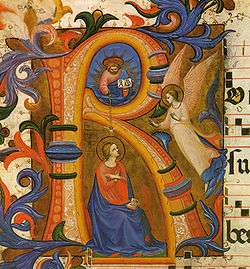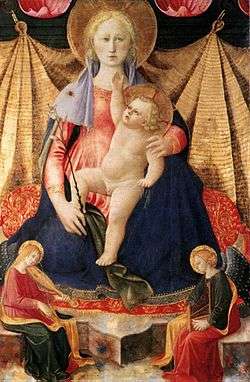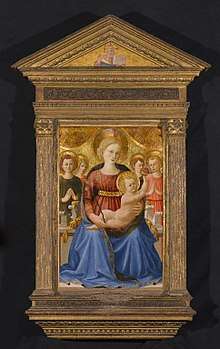Zanobi Strozzi
Zanobi Strozzi (17 November 1412 – 6 December 1468) was an Italian painter and manuscript illuminator, active in his native Florence and nearby Fiesole. He was evidently closely associated with Fra Angelico, if not perhaps a formal pupil as Vasari says.[1] He is "almost certainly identifiable" with the "Buckingham Palace Master".[2] Most surviving works are manuscript illuminations, but several panel paintings survive, including six altarpieces and six panels with the Virgin and Child,[3] as well as some designs for metalwork.


Vasari says Strozzi "painted pictures and panels for a great many private houses in Florence" (per tutta Fiorenza, per le case de' cittadini) and mentions some in churches, as well as a double portrait.[4] He may have been something of a pioneer in producing small pictures for homes that departed from the usual subject of the Virgin and Child.[5]
He was one of the most important illuminators in Florence in his day, and his contribution to eighteen manuscripts can be documented, normally as one of a group of artists, strongly contrasting with his undocumented paintings, which are mostly attributed to him on the basis of style alone.[6]
Biography
He was born in Florence, a member of the extended Strozzi family,[7] who during his lifetime lost their battle for primacy within Florence with the Medici family, but were still noble and wealthy. He was orphaned at the age of 15, and then lived with the artist Battista di Biagio Sanguigni, described as his "tutor" but probably also his master in the usual painter sense. Some time between 1427 and 1430 the pair moved to Fiesole, some five miles from Florence.[7]
He is not recorded as joining the artist's guild or Arte dei Medici e degli Speziali, meaning that he could not contract for paintings (as opposed to illuminations) under his own name within Florence.[7] Vasari, in his biography of Fra Angelico, named him as a pupil,[8] who had probably met him in the thirties at San Domenico, Fiesole, the master's base until 1436.
In 1438, he married Nanna Francesco Strozzi and moved into a new house in the same parish in Fiesole.[1] Before that he was sharing a house with Sanguigni, with whom he may have collaborated.[9] When Fra Angelico moved to Rome in 1446, Strozzi moved to a rented house in Florence, in the parish of San Paolo, near Santa Maria Novella. In 1450 he bought a house in another parish.[10] He is buried in Santa Maria Novella, Florence.[2]
Works

Panel paintings
His only "signed" painting is an Annunciation for the church of San Miniato al Monte (c. 1440-45), now in the National Gallery in London. This has lettering semi-hidden in the decorated gold border to the Virgin's dress reading "Z" (reversed), followed by "A", then after a gap filled with ornament, "NOBI".[2]
An altarpiece now split between several museums has been reconstructed. The main panel is a Virgin and Child now in the Hermitage Museum, and there are side panels of saints, namely: "on the left, Saints Nicholas, Lawrence, and John the Baptist (Hyde Collection, Glens Falls, New York), and, on the right, Saints Zenobius, Francis, and Anthony of Padua (Yale University Art Gallery, New Haven)." That the three top panels belong together is rather conclusively shown by the end Yale robe running over into the Hermitage panel.[11] Somewhat less certain as members of the same group are the two predella panels with Nativity scenes attributed to Zanobi Strozzi, an Adoration of the Magi in the National Gallery in London, and a Nativity (strictly an Adoration of the Child) in the Metropolitan Museum of Art in New York.[12]
Around 1460 the Medici commissioned him an altarpiece for the church of San Girolamo in Fiesole, sponsored by the family due to its proximity to their new Villa Medici in Fiesole. This is now in the Musée du Petit Palais, Avignon. An Annunciation in Philadelphia is also attributed to him.[2]
Some lost paintings are documented. From 1434 to 1439 he painted a panel for a partition of the church of Sant'Egidio, Rome, possibly the Madonna and Child with Four Angels today at the Museum of San Marco in Florence. There was also a painted crucifix for San Marco recorded in 1448.[2]
Vasari mentions a double portrait of Giovanni di Bicci de' Medici (d. 1429), founder of that family's fortune, and Bartolommeo di Taldo Valori, a leading ally of his. In Vasari's day this was in an intimate room of his patron Cosimo I de' Medici, Grand Duke of Tuscany.[8] Given the dates, the portrait of Giovanni de' Medici may have been posthumous; Strozzi was about seventeen when he died.
A large Last Judgement was in Berlin but was one of many paintings that disappeared in World War II. A smaller version of the subject is in a private collection.[13]
Of his six Virgin and Child panels, five use the type called the Madonna of humility, where the Virgin sits on the ground or a low and plain seat, rather than a throne. The exception, and probably the latest of the group, is the painting in Brooklyn (illustrated). The earliest of the six, in the Royal collection, gave rise to his old notname of the "Buckingham Palace Master".[14]
There are a few small panel paintings, including a Nativity in the Metropolitan Museum of Art, only 33 x 23 cm, that appears never to have been part of a larger format, but an individual subject for private devotion. At this period such images were usually of the Virgin and Child. An Annunciation in Philadelphia and an enthroned God the Father in Paris are a similar size.[5]
Illuminations
As an illuminator, he was responsible with Filippo di Matteo Torelli for several choir books for the church of San Marco, carried out between 1446 and 1454, commissioned by Cosimo de' Medici.[2] In 1463, in collaboration with Francesco di Antonio del Chierico, he helped illuminate a choir-book of the Cathedral of Florence, now in the Laurentian Library (Nos. 149, 150, 151). The collaboration with Francesco took eleven years and took the help of an entire workshop which included the young Cosimo Rosselli, Domenico Ghirlandaio, Attavante Attavanti and the Master of the Hamilton Xenophon.[15] He also collaborated with Francesco Pesellino and Domenico di Michelino.
A set of nine grisaille designs in pen, wash and gouache are spread between several museums. Based on works by Fra Angelico, they are probably designs for a goldsmith to follow, for sections of a reliquary or similar piece. Probably the set was originally larger.[16]
Notes
- Kanter and Palladino, 228; Gordon, 406
- Gordon, 406
- Kanter and Palladino, 258
- Vasari, 126; Italian from Kanter and Palladino, 258
- Kanter and Palladino, 266
- Kanter and Palladino, 229-230
- Kanter and Palladino, 228
- Vasari, 126
- Gordon, 422
- Kanter and Palladino, 229
- Kanter and Palladino, 242-245, with a reconstruction illustrated at 244; Christiansen (quoted)
- Kanter and Palladino, 242-245
- Kanter and Palladino, 246-248
- Kanter and Palladino, 260-261, 264
- Garzelli
- Kanter and Palladino, 251-256
References
- Christiansen, Keith, Met "catalogue" entry, on Nativity Scene's web page, 2012
- Garzelli, Annarosa (31 March 2000), "Francesco di Antonio del Chierico" in Grove, Oxford Art Online.
- Gordon, Dillian, National Gallery Catalogues (new series): The Fifteenth Century Italian Paintings, Volume 1, 2003, ISBN 1857092937
- Kanter, Laurence, and Pia Palladino, with contributions by Magnolia Scudieri, Carl Brandon Strehlke, Victor M. Schmidt, and Anneke de Vries, Fra Angelico, 2005, New York: The Metropolitan Museum of Art, google books
- Vasari, selected & ed. George Bull, Artists of the Renaissance, Penguin 1965 (page nos from BCA edn, 1979)
Further reading
- Ada Labriola (ed.), Fra Angelico in Pontassieve, Mandragora, Florence 2010. ISBN 9788874611492
- Strehlke, Carl Brandon (1994). In Laurence B. Kanter and Barbara Drake Boehm. Painting and Illumination in Early Renaissance Florence 1300-1450. New York: The Metropolitan Museum of Art. pp. 349–50
External links
| Wikimedia Commons has media related to Zanobi Strozzi. |